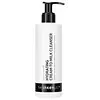What's inside
What's inside
 Key Ingredients
Key Ingredients

No key ingredients
 Benefits
Benefits

 Concerns
Concerns

 Ingredients Side-by-side
Ingredients Side-by-side

Water
Skin ConditioningGlycerin
HumectantEthylhexyl Palmitate
EmollientC12-15 Alkyl Benzoate
AntimicrobialPEG-6 Caprylic/Capric Glycerides
EmulsifyingBetaine
HumectantPolyglyceryl-3 Dicitrate/Stearate
EmulsifyingSodium Acrylate/Sodium Acryloyldimethyl Taurate Copolymer
Emulsion StabilisingIsohexadecane
EmollientPentylene Glycol
Skin ConditioningPropanediol
SolventButyrospermum Parkii Butter
Skin ConditioningHydroxyacetophenone
AntioxidantOryza Sativa
Caprylyl Glycol
EmollientCetearyl Olivate
Polysorbate 80
EmulsifyingSorbitan Olivate
EmulsifyingEthylhexylglycerin
Skin ConditioningSodium Hydroxide
BufferingSorbitan Oleate
EmulsifyingXanthan Gum
EmulsifyingHydrolyzed Rice Protein
Skin ConditioningOryza Sativa Bran Oil
EmollientInulin
Skin ConditioningPolyquaternium-10
Hydrolyzed Sodium Hyaluronate
Skin ConditioningSodium Hyaluronate
HumectantPhenoxyethanol
PreservativeLecithin
EmollientWater, Glycerin, Ethylhexyl Palmitate, C12-15 Alkyl Benzoate, PEG-6 Caprylic/Capric Glycerides, Betaine, Polyglyceryl-3 Dicitrate/Stearate, Sodium Acrylate/Sodium Acryloyldimethyl Taurate Copolymer, Isohexadecane, Pentylene Glycol, Propanediol, Butyrospermum Parkii Butter, Hydroxyacetophenone, Oryza Sativa, Caprylyl Glycol, Cetearyl Olivate, Polysorbate 80, Sorbitan Olivate, Ethylhexylglycerin, Sodium Hydroxide, Sorbitan Oleate, Xanthan Gum, Hydrolyzed Rice Protein, Oryza Sativa Bran Oil, Inulin, Polyquaternium-10, Hydrolyzed Sodium Hyaluronate, Sodium Hyaluronate, Phenoxyethanol, Lecithin
Water
Skin ConditioningHelianthus Annuus Seed Oil
EmollientEthylhexyl Palmitate
Emollient1,2-Hexanediol
Skin ConditioningPolyglyceryl-10 Myristate
Skin ConditioningArachidyl Alcohol
EmollientGlycerin
HumectantCetearyl Alcohol
EmollientButylene Glycol
HumectantBehenyl Alcohol
EmollientArachidyl Glucoside
EmulsifyingGlucose
HumectantCoco-Glucoside
CleansingGlyceryl Stearate
EmollientDioscorea Japonica Root Extract
Skin ConditioningHibiscus Esculentus Fruit Extract
Skin ConditioningNelumbo Nucifera Root Extract
Skin ConditioningUndaria Pinnatifida Extract
Skin ConditioningLaminaria Japonica Extract
Skin ProtectingGlycine Max Seed Extract
Skin ConditioningCocos Nucifera Fruit Extract
EmollientOryza Sativa Extract
AbsorbentPrunus Amygdalus Dulcis Seed Extract
Skin ConditioningAvena Sativa Meal Extract
SoothingCitric Acid
BufferingXanthan Gum
EmulsifyingSodium Polyacrylate
AbsorbentWater, Helianthus Annuus Seed Oil, Ethylhexyl Palmitate, 1,2-Hexanediol, Polyglyceryl-10 Myristate, Arachidyl Alcohol, Glycerin, Cetearyl Alcohol, Butylene Glycol, Behenyl Alcohol, Arachidyl Glucoside, Glucose, Coco-Glucoside, Glyceryl Stearate, Dioscorea Japonica Root Extract, Hibiscus Esculentus Fruit Extract, Nelumbo Nucifera Root Extract, Undaria Pinnatifida Extract, Laminaria Japonica Extract, Glycine Max Seed Extract, Cocos Nucifera Fruit Extract, Oryza Sativa Extract, Prunus Amygdalus Dulcis Seed Extract, Avena Sativa Meal Extract, Citric Acid, Xanthan Gum, Sodium Polyacrylate
 Reviews
Reviews

Ingredients Explained
These ingredients are found in both products.
Ingredients higher up in an ingredient list are typically present in a larger amount.
Ethylhexyl Palmitate, also known as octyl palmitate, is created from 2-ethylhexyl alcohol and palmitic acid. It is a fatty acid ester.
The fatty acid content of Ethylhexyl Palmitate makes it an emollient. Emollients help soften and hydrate your skin by trapping moisture within.
Ethylhexyl Palmitate is also used to help improve the texture of cosmetics. It helps other ingredient dissolve in products and help disperse ingredients more evenly.
You'll likely find this ingredient in sunscreen, as it is often used to mix UV-blocking ingredients such as avobenzone and ethylhexyl triazone.
It can also help stabilize the fragrances in a product as a fragrance fixative.
Ethylhexyl Palmitate can be used to substitute mineral oil.
Due to its high fatty acid content, it may not be fungal-acne safe.
Learn more about Ethylhexyl PalmitateGlycerin is already naturally found in your skin. It helps moisturize and protect your skin.
A study from 2016 found glycerin to be more effective as a humectant than AHAs and hyaluronic acid.
As a humectant, it helps the skin stay hydrated by pulling moisture to your skin. The low molecular weight of glycerin allows it to pull moisture into the deeper layers of your skin.
Hydrated skin improves your skin barrier; Your skin barrier helps protect against irritants and bacteria.
Glycerin has also been found to have antimicrobial and antiviral properties. Due to these properties, glycerin is often used in wound and burn treatments.
In cosmetics, glycerin is usually derived from plants such as soybean or palm. However, it can also be sourced from animals, such as tallow or animal fat.
This ingredient is organic, colorless, odorless, and non-toxic.
Glycerin is the name for this ingredient in American English. British English uses Glycerol/Glycerine.
Learn more about GlycerinWater. It's the most common cosmetic ingredient of all. You'll usually see it at the top of ingredient lists, meaning that it makes up the largest part of the product.
So why is it so popular? Water most often acts as a solvent - this means that it helps dissolve other ingredients into the formulation.
You'll also recognize water as that liquid we all need to stay alive. If you see this, drink a glass of water. Stay hydrated!
Learn more about WaterXanthan gum is used as a stabilizer and thickener within cosmetic products. It helps give products a sticky, thick feeling - preventing them from being too runny.
On the technical side of things, xanthan gum is a polysaccharide - a combination consisting of multiple sugar molecules bonded together.
Xanthan gum is a pretty common and great ingredient. It is a natural, non-toxic, non-irritating ingredient that is also commonly used in food products.
Learn more about Xanthan Gum